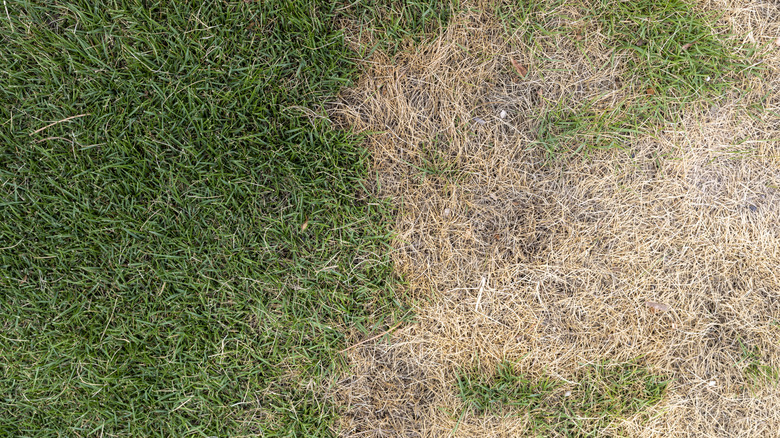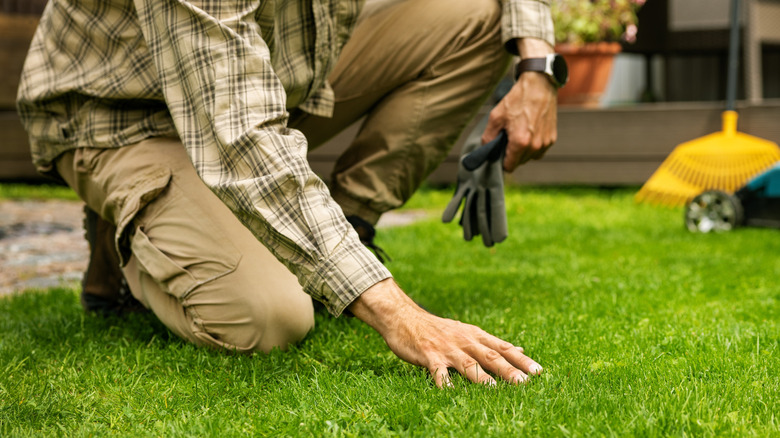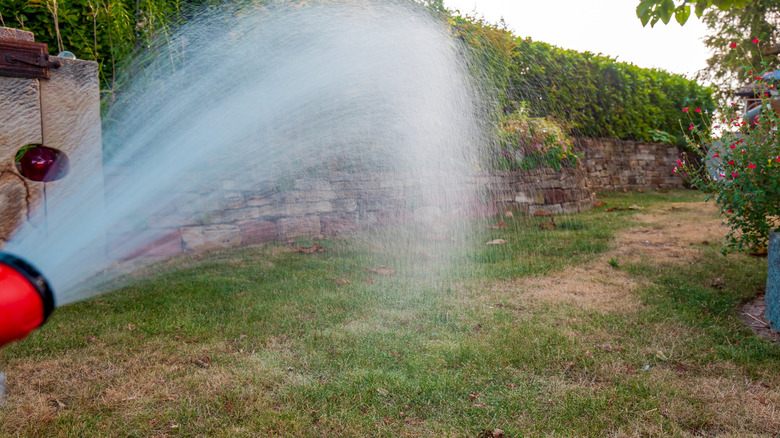The Easy Way To Tell If Your Lawn's Perennial Ryegrass Is Dead Or Just Dormant
Anyone living somewhere with a cool and mild climate such as the Pacific Northwest probably knows the beauty of a lush green perennial ryegrass (Lolium perenne L.) lawn. Homeowners love this grass because it flourishes year-round even during the colder parts of the year when more traditional lawn types, like Kentucky bluegrass, go dormant. Likewise, perennial ryegrass also has the ability to go dormant, and will if it is planted in a hotter and dryer climate (say around 80-90 degrees Fahrenheit). Dormant grass goes brown in the summer the same way dead grass does, so it can be tough to determine the state of your grass until you pull some, check its crown color, feel its texture, check its visual pattern, and run a watering test.
Dormancy for perennial ryegrass is a perfectly natural function. It is a reaction to extreme temperatures and a lack of water that causes it to switch priorities on where to send nutrition to. During its normal state, perennial ryegrass sends nutrients from its roots up through its blades giving it that lush look everyone loves. In dormancy, that priority shifts to keeping the plant alive until it cools again; here it conserves by only sending nutrients to the crown and shallow root system, which causes it to look similar to how it would if it was dead. So if you notice your perennial ryegrass lawn has turned brown, how do you tell whether it has gone dormant or died?
How to tell death from dormancy
Determining if your lawn is actually dead or simply dormant can be difficult at first glance. While both states appear brown and lifeless, there are some ways to easily distinguish between the two. First, look it over. Dead grass has a consistently brown or yellow look; dormant grass, however, has a patchier look that will likely even have some faded green spots. This won't tell you everything, though, so there are some other steps you can take. Next, grab a small chunk and pull. Dormant grass is still alive and sending nutrients to the crown and roots, so if there is some resistance, it is likely just dormant; dead grass easily pulls right up.
Now, look at the grass' crown, right where the blades meet the roots at soil level. Dormant grass may appear brown up top, but its crown will still have a pale green or whitish color, indicating life; dead grass is purely brown or gray. Another good test is to determine the grass' texture. While dormant grass is dry, its blades are still a little flexible. Dead grass, as you may guess, feels brittle and will crumble easily if you press on it. Lastly, if you are still unsure, do a water test. With this, try watering a small patch consistently for a few days. If the grass is merely dormant, you should start to see some green returning within a week or two; dead grass won't, no matter how much you water it.
How to maintain dormant perennial ryegrass
If you have determined that your ryegrass is simply dormant, what you need to do at this point is help it survive until the weather cools down. Maintenance here is simple as long as you follow some basic do's and don'ts. The first and biggest "don't" is being on it. Dormancy is a fragile state, so resist walking, sitting, or putting anything on it. Dormant ryegrass also is not in a place where it is taking in additional nutrients, so skip applying any fertilizers on it — you just need to wait until it is cooler out for the grass to exit dormancy.
On the flip side, there are things you can do to make sure your ryegrass lawn stays healthy while it is dormant. The most important "do" is to keep watering it. The ryegrass does not need anywhere near the amount of water it would normally require when it is not dormant; about 1 inch per week will keep it happy. And likewise, mow it consistently but make this tweak: Adjust the blade height to 4 inches; any shorter than this and you will risk causing damage to the roots. With these easy tips, you can verify whether your perennial ryegrass is dormant or dead and take care of it until it's cooler and ready to make your yard lush and covered in no time.


